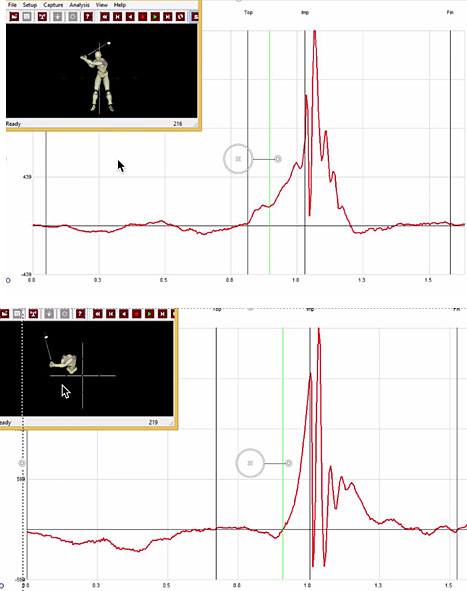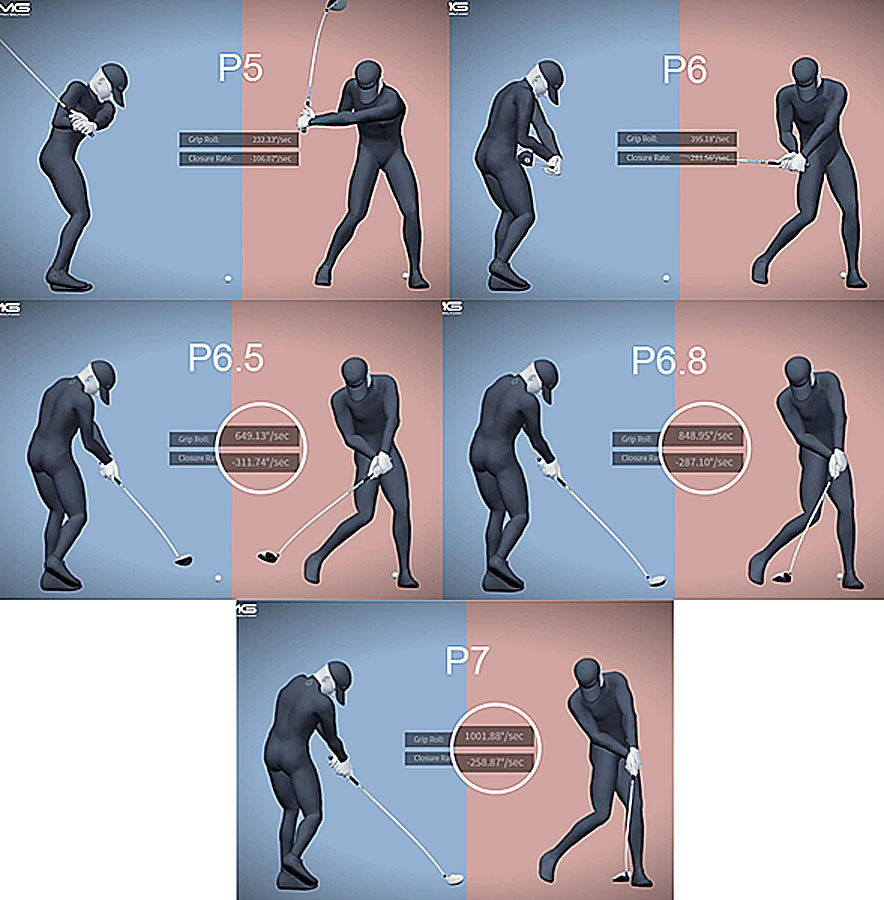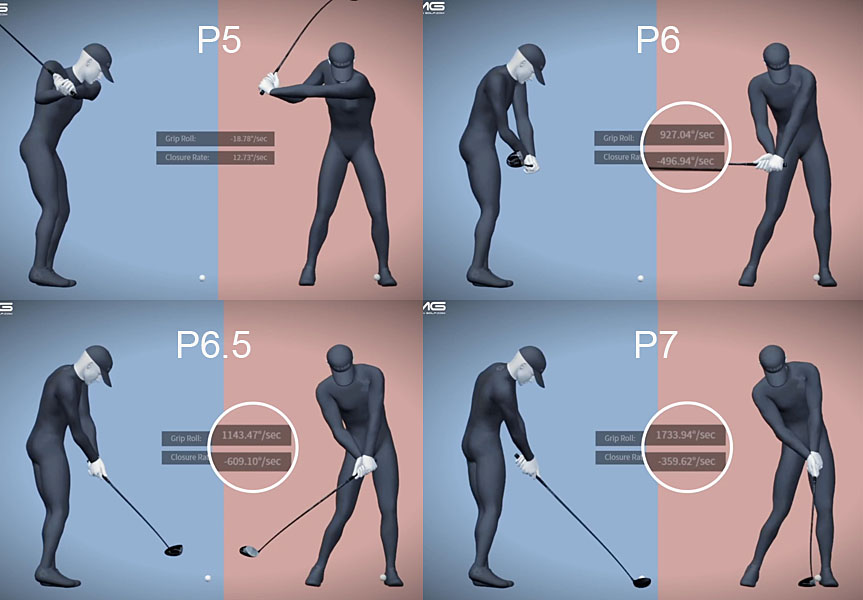
Extract from a short book review paper that I am writing on Tyler Ferrell's book "The Stock Tour Swing".
Topic number 1: The topic of clubface-closing during the downswing and an analysis of the "motorcycle move".
Graph presentation.

These graphs are presented by Tyler Ferrell in one of his videos and they show the rate of handle twist velocity of the clubshaft (axial velocity of the clubshaft around its longitudinal axis) during the downswing between the top of the backswing and impact (between the two vertical black lines located centrally). The vertical green line represents the downswing position as shown in the stick figure image accompanying the graphs.
The top graph shows the handle twist velocity in a professional golfer - note that the handle twist velocity increases gradually throughout the downswing and note that it peaks just before impact. The handle twist phenomenon happening during the entire downswing is supposedly due to the "motorcycle move" in the early downswing and due to left forearm supination in the later downswing.
The bottom graph shows the handle twist velocity in a scratch amateur golfer - note that the handle does not twist around its longitudinal axis during the early downswing and that it only starts to twist around its longitudinal axis in the mid-downswing (after the green vertical line). Note that its speed of axial rotation increases dramatically in the later downswing and that it reaches its peak velocity just before impact. Virtually all of the handle twist phenomenon happening during the late downswing is due to left forearm supination and it represents the release of PA#3 (in TGM terminology).
Tyler Ferrrell claims that virtually all professional golfers start to twist their clubshaft around its longitudinal axis during the early downswing (by using the "motorcycle move"), and that they produce a gradual clubface-closing pattern during the downswing phase - in contrast to amateur golfers who delay their clubface-closing and who are then obliged to rapidly close the clubface in the later downswing (via the biomechanical mechanism of left forearm supination).
However, I think that Tyler Ferrell's opinion is unfounded, and not supported by the scientific evidence.
Here is a graph of the handle twist velocity in 92 professional golfers from Phil Cheetham's research study on "The Relationship of Handle Twist Velocity to Selected Biomechanical Characteristics of the Golf Drive", which is available at http://www.philcheetham.com/phd-dissertation-and-presentation/

The top graph plots the handle twist velocity during the downswing. The green
vertical line in the top graph represents the time point when the
clubshaft first starts to release (PA#2 release) and that happens before the
twist release point (which usually happens a little later in the mid-downswing
at-or-after P5.5). Note that there is a slow phase of handle twist velocity
in the later phase of the mid-downswing and the early phase of the late
downswing (see yellow-colored block) and note that the handle twist
velocity rate increases dramatically in the later downswing before
reaching its peak velocity just before impact.
The bottom graph shows the angular velocity of left wrist ulnar-radial deviation (red graph), the angular velocity of extension-flexion (green graph) and the angular velocity of left forearm supination-pronation (blue graph). The vertical green line represents the club release time point (PA#2 release time point) - when the club first starts to release due to left wrist ulnar deviation. Note that the left wrist only starts to supinate in the later mid-downswing (see vertical green arrow) and that the velocity of left forearm supination is slow between the vertical green arrow and the violet vertical arrow. Note that the speed of left forearm supination increases dramatically in the later downswing and that it reaches its peak velocity at impact. Note that the left wrist becomes slightly more extended (cupped) in the early downswing and that it reaches its greatest speed of left wrist extension just after the green vertical arrow. Note that there is no left wrist flexion happening in the early downswing before the golfer reaches the P5.5 position. Note that the left wrist extension graph moves in the direction of left wrist flexion after the vertical green arrow and that the left wrist reaches its peak speed of left wrist flexion just before impact. Note that there is no evidence in these graphs that indicate that those professional golfers are using the "motorcycle move" in the early-mid downswing (as recommended by Tyler Ferrell).
Many other golf instructors are also actively promoting the idea of closing the clubface in the early downswing by using the "motorcycle move" (also called the "reverse motorcycle move") and here is an example - where Mike Granato promotes the "reverse motorcycle move" in the early downswing between P4 and P5 (which he calls the "pro zone").
"How to Drive It Like a Pro: Squaring the Clubface" - https://www.youtube.com/watch?v=pTxm4jGcsvY
In that video, Mike Granato features two golfers he believes are using the "reverse motorcycle move" during the early downswing. He is correct with respect to the first golfer that he features in his video, but he is incorrect with respect to the second golfer that he features in the video.
Here are capture images of the first featured golfer.

The images are produced using the GEARS 3-D system, and he has published both grip roll measurements and clubface closure rate measurements at different time points during the downswing.
Note that at P5, that the grip roll measurement is 233 degrees/second and that the clubface closure rate is 106 degrees/second. Those values are fully compatible with a "reverse motorcycle move" maneuver and one can see in the accompanying stick figure images that the golfer has bowed his left wrist and that the clubface looks slightly closed to the clubhead arc.
Note that at P6, that the grip roll measurement is 395 degrees/second and the clubface closure rate is 211 degrees/second. Part of that grip roll measurement and clubface closure measurement can be due to a continued "finger torquing" action, which is the biomechanical basis of the "reverse motorcyle move" maneuver, and part of it is likely due to his early left forearm supination maneuver (which can be seen in the accompanying stick figures). Note that his clubface is closed relative to the watchface area of his left lower forearm and that is likely due to his use of a "reverse motorcycle move" (involving a left wrist palmar flexion manuever) that is combined with an early left forearm supinatory action.
Note that at P6.5, that the grip roll measurement is 649 degrees/second and the clubface closure rate is 311 degrees/second. I strongly suspect that most of the counterclockwise grip roll and clubface closure happening at this time point in the late downswing is due to the rapid phase of left forearm supination (as seen in Phil Cheetham's graph).
Note that at P6.8, that the grip roll measurement is 848 degrees/second and the clubface closure rate is 287 degrees/second. I strongly suspect that all of the counterclockwise grip roll and clubface closure happening at this time point in the very late downswing is due to the rapid phase of left forearm supination (as seen in Phil Cheetham's graph).
Note that at impact, that the grip roll measurement is 1,001 degrees/second and the clubface closure rate is 258 degrees/second. I strongly suspect that all of the counterclockwise grip roll and clubface closure happening at this time point in the very late downswing just before impact is due to the rapid phase of left forearm supination (as seen in Phil Cheetham's graph).
It is important to understand that the use of the "reverse motorcycle move" in the early downswing does not mean that the golfer can avoid using a PA#3 release action (due to a rapid left forearm supination phenomenon) in the later downswing. This first featured golfer is obviously rotating the grip handle very fast counterclockwise in his late downswing between P6.5 and impact secondary to the use of a rapid left forearm supinatory motion and that represents the release of PA#3 (in TGM terminology). So, Mike Granato is totally incorrect to label this P6.5 to P7 zone the "no zone". The true reality is that the "reverse motorcycle move" effect (that is biomechanically secondary to a finger torquing action due to the active muscular contraction of the flexor digitorum muscles to the left hand's 3rd, 4th and 5th fingers) automatically/naturally dissipates in the later downswing when the club releases thereby causing the left wrist to become progressively less radially-deviated and that club releasing phenomenon (combined with the significant centrifugal forces in play) stretches the flexor digitorum muscles to such a significant degree that they are biomechanically incapable of executing the "reverse motorcycle move" phenomenon during the late downswing between P6.5 and impact.
Now consider the second featured golfer in Mike Granato's video.

Note that at P5, that the grip roll measurement is 18 degrees/second and the
clubface closure rate is 12 degrees/second. Those measurements are
insignificantly small, and there is no evidence that the second featured golfer
is using the "reverse motorcycle move" in his early downswing between P4 and P5.
Note that the golfer has an intact LAFW and a GFLW, and that his left wrist is
not palmar flexed.
Note that at P6, that the grip roll measurement is 926 degrees/second and that the clubface closure rate is 496 degrees/second. The counterclockwise rotation of the grip is most likely due to a left forearm supination phenomenon (equivalent to the slow phase of left forearm supination seen in Phil Cheetham's graph) and there is no biomechanical evidence that the golfer is using a "reverse motorcycle move" manuever - note that the golfer still has a GFLW and he does not have an overtly palmar flexed left wrist. Also, note that his clubface is straight-in-line (parallel) to the watchface area of his left lower forearm (which is indicative of an intact LAFW alignment and which is incompatible with the presence of a "reverse motorcycle move" phenomenon).
Note that at P6.5, that the grip roll measurement is 1143 degrees/second and that the clubface closure rate is 609 degrees/second. Those measurements are representative of the measurements seen in the rapid phase of left forearm supination seen in Phil Cheetham's graph - after the vertical violet-colored arrow - and they represent the release of PA#3 (in TGM terminology).
Note that at impact, that the grip roll measurement is 1733 degrees/second and that the clubface closure rate is 359 degrees/second. Those measurements are representative of the measurements seen in the rapid phase of left forearm supination seen in Phil Cheetham's graph - after the vertical violet-colored arrow - and they represent the release of PA#3 (in TGM terminology).
The second featured golfer is obviously not using a "reverse motorcycle move" in his early-mid downswing and he closes the clubface in his later downswing by using the standard PA#3 release action (which is biomechanically secondary to a left forearm supination phenomenon). Mike Granato is totally incorrect when he implies that this second golfer is not closing his clubface actively (using a left forearm supinatory motion) during the "no zone" between P6 and impact.
Both golfers are using the standard PA#3 release action (which is based on a left forearm supinatory motion) to close their clubface relative to the clubhead path in the late downswing. However, the amount of left forearm supinatory roll happening during their respective PA#3 release actions will be slightly less in the first golfer because he already closed his clubface in the earlier downswing between P4 and P6 by approximately 20-30 degrees (relative to the clubhead path) by using a "reverse motorcycle move", so his clubface is slighly more closed relative to the clubhead path at the start of the late downswing (at the P6 position).
Another "fact" that Mike Granato gets totally incorrect relates to the amount of grip roll force that is transmitted to the clubface closing phenomenon. At the 2:45 minute time point of his video, Mike Granato states that the grip roll measurement in the first golfer is 1,001 degrees/second just before impact while the clubface closure rate measured at that same time point is 258 degrees/second. Mike then implies that only 25% of the grip roll's counterclockwise rolling effect is transmitted down the clubshaft to the clubface! He is totally wrong! The true reality is that 100% of the grip roll's counterclockwise rolling effect is transmitted down the clubshaft and it causes the clubface to roll by the exact same amount if measured over a finite distance of grip/clubhead travel time. Mike totally ignores the fact that the clubhead end of the clubshaft is traveling a much longer distance than the grip handle per unit time during the late downswing and he needs to take that fact into account when calculating whether the grip rolls the same amount as the clubface during the late downswing action. So, for example, if a golfer uses a neutral left hand grip, then the clubface will be straight-line-aligned relative to the watchface area of the left lower forearm at address (if he doesn't bend his left wrist at address). Then, if that golfer adopts an intact LAFW/GFLW golf swing technique, the true reality is that the clubface will always remain straight-line-aligned relative to the watchface area of the left lower forearm throughout the entire downswing, and that means that the amount of grip roll happening per unit time must be the same as the amount of the clubface closure roll happening per unit time. However, the clubhead arc path is much longer than the hand arc path during the late downswing, so the clubhead is traveling a much longer distance per unit time than the grip handle, and Mike Granato does not take that fact into account. The amount of grip and clubface roll happening per unit time must be calculated by the multiplying the instantaneous grip roll/clubface roll measurement in degrees/second by the amount the grip/clubface travels during that same measured time period (eg, from P6.5 to P7) and they have to be roughly the same amount.
Consider an example - by studying these capture images of Dustin Johnson's late downswing.

Image 3 shows Dustin Johnson at the P6 position, image 4 shows him at the P6.5
position, image 5 shows him at the P6.8 position and image 6 shows him at
impact.
Note how small is the distance that his hands have moved targetwards between P6.5 (image 4) and P6.8 (image 5) and they have probably only moved forwards along his hand arc path by about 3". However, note that his clubhead has probably traveled about 12" forward along the clubhead path during that same time period. It is actually not possible to accurately estimate the amount the clubhead has traveled between P6.5 and P6.8 from viewing face-on capture images, because the clubhead arc is rounded and angled relative to the camera. Also, the i) shape of the clubhead path, and ii) the amount that the clubhead travels along the clubhead path, is very much affected by the accumulator #3 angle that exists during that P6.5 => P6.8 time period. Nonetheless, despite the presence of these complicating factors, the true reality is that the total amount of grip roll must be *roughly equal to the total amount of clubface roll happening during that P6.5 => P6.8 time period.
(* I stated that the amount of grip roll must be roughly the same as the amount of clubface closure, but there may be a small/insignificant discrepancy because of factors like shaft twist tensile strength factors and shaft forward-kick factors that can cause the clubhead end of the shaft to temporarily twist/travel a little faster than the grip end of the shaft during the later downswing).
Finally, if you note the grip roll and clubface roll measurements for the second golfer at P6.5 and P7 (just before impact), those published measurements are as follows-:
P6.5 position - Grip roll = 1143 degrees/second; clubface closure = 609 degrees/second. That is rougly a 2:1 relationship.
P7 position (just before impact) - Grip roll = 1733 degrees/second; clubface closure = 359 degrees/second. That is roughly a 5:1 relationship.
Why is that ratio changing so that the grip roll measurement becomes much larger relative to the clubface closure measurement between P6.5 and impact? The answer is obvious if you consider the fact that hands are slowing down in the late downswing in most professional golfers between P6.7 and impact, but the clubhead is traveling much faster just before impact than it was traveling at P6.5. Those two factors explain why the relative relationhsip of grip roll (relative to clubface closure) will become progressively greater during the late downswing between P6.5 and impact.
Jeff Mann.
May 2018.